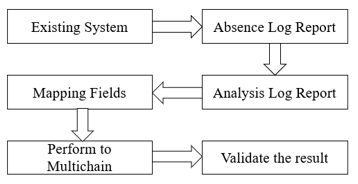Recording of Student Attendance with Blockchain Technology to Avoid Fake Presence Data in Teaching Learning Process
Volume 6, Issue 1, Page No 742-747, 2021
Author’s Name: Meyliana1, Yakob Utama Chandra1, Cadelina Cassandra1, Surjandy1,a), Erick Fernando1, Henry Antonius Eka Widjaja1, Andy Effendi1, Ivan sangkereng2, Charles Joseph3, Harjanto Prabowo4
View Affiliations
1Information Systems Department, School of Information Systems, Bina Nusantara University, Jakarta, 11480, Indonesia
2Management Department, BINUS Online Learning, Bina Nusantara University, Jakarta, 11480, Indonesia
3PT. PineappleTech Multi Cemerlang, Jakarta, 11480, Indonesia
4Computer Science Department, Bina Nusantara University, Jakarta, 11480, Indonesia
a)Author to whom correspondence should be addressed. E-mail: surjandy@binus.ac.id
Adv. Sci. Technol. Eng. Syst. J. 6(1), 742-747 (2021); ![]() DOI: 10.25046/aj060181
DOI: 10.25046/aj060181
Keywords: Blockchain Technology, Blockchain Education, Qualitative Research, Blockchain Graduation
Export Citations
University operational activities are a routine part of university operations and supervisory control and monitoring function. The low controlling and monitoring of operational activities can cause irrelevance in the teaching and learning process. A graduate may have a graduation document but has never attended the teaching and learning process. An official institution can issue this graduation document, but it is fake because no teaching-learning activity occurred. It happens because the data is easily being manipulated and changed in the current system. From the problem, this is what drives this research to be carried out. With the characteristics of distributed, secure, and traceable information, Blockchain will solve this problem. Based on a previous study, blockchain technology facilitates university operational activities so that it will solve the current problems. This research uses qualitative research methods. The research process starts with literature studies and forum group discussions conducted on nine universities in Indonesia (public and private universities). This study used the User-Centered Design Technique. This research focuses on the user, so the results possibly are applied. The research results prove that Blockchain technology can record student attendance as part of the graduation process’s teaching and learning process. Blockchain’s immutable, unchangeable, and distributed characteristics will ensure the student attendance record’s validity in the teaching and learning process.
Received: 08 December 2020, Accepted: 24 January 2021, Published Online: 05 February 2021
1.Introduction
The problem of graduation documents forgery has risen in various countries. Several previous studies have reported that graduation documents forgery requires a new solution, Blockchain technology uses to be a solution [1], [2]. Other research states that Blockchain technology uses record operation activity in a university to protect information [3], [4]. This research tried to simulate the use of Blockchain technology (multichain) [5] to record student attendance because Blockchain characteristics such as distributed [6], secure, and traceable information [7], [8]. Blockchain will be a new solution to this problem [9], [10]. To prevent the falsification of graduation documents issued by the Institution (such as fake attendance report). The irregularity was found because several universities issue original graduation documents, but the graduate had never conducted academic activities [11]. The early research stated a similar issue regarding fake attendance [12].
Blockchain technology is expected to provide a solution to this problem. This qualitative research was conducted by involving 9 universities, private and public universities, to obtain input and validation of the simulation result. The technique used in the research is user-centered design (UCD) [13], [14]. By using the UCD technique, the research results will prioritize the user needs. This study aims to test blockchain technology for student attendance recording. The simulation results found blockchain technology can facilitate record student attendance during the lecture process, which is very important as a control and supervision function over university operations. The limitations of the existing system capabilities such as user easily to update the data. But with Blockchain technology, which can record data and not easily be manipulated and changed, even the data will always be immutable. After obtaining validation from 9 universities, the final result of this study stated that blockchain technology can be used for recording the attendance lists. This systematic writing of this paper starts with an abstract, introduction, literature, method, result and discussion and finally, the conclusion. The research stages can be seen in Figure 1 below.
Exhibit at Figure 1, the first research stage began with a literature review. This literature review found graduates who had graduation documents, but graduates were never found to be present in lectures. Another study found that Blockchain can handle this problem. The next step was to conduct FGDs with nine private and public universities to find necessary fields to support attendance records. After determining the fields, mapping is carried out to record student attendance into the blockchain (multichain) application and directly written into the multichain application (Blockchain). After that, a simulation was carried out and validated to 9 universities through FGD.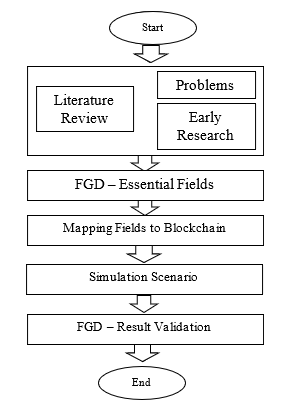 Figure 1: Research Stages
Figure 1: Research Stages
2. Literature Review
This session will describe some of the theories used in this study.
2.1. Multichain
Multichain is a platform created in 2015[5]. Multichain made for cryptocurrency. Multichain is a blockchain with private and permission types. The simulation carried out is limited to a laboratory at the university, but the simulation data are real data from the current system.
2.2. Blockchain for Education
Blockchain technology discovers in 2008 [15], and after a cryptographer in 2014 [16] combines smart content features into Blockchain technology. Many previous studies have stated that blockchain technology can be used to improve the process and activities in education, such as borrowing books or libraries [17], students loan [18], for graduation documents [19], [20], and others in education [1], [21]. From previous research, it can be said that Blockchain is not only for cryptocurrency but also for support operations in education.
2.3. Blockchain Characteristics
Blockchain Technology’s characteristics help monitor lecture activities to minimize the occurrence of fake graduation documents, especially those issued by institutions that have the authority to issue documents. The characteristics of Blockchain are [6], [16]:
- Immutable, which means that information that has been recorded on the Blockchain will always be there and never deleted. In this case, attendance records that occur as a result of students coming to attend lectures will continue to be recorded forever and cannot be removed.
- Unchangeable, which means the information that has been recorded on the Blockchain cannot be changed or updated forever. In this case, the attendance that occurs as a result of students coming to attend lectures will continue to be recorded forever and cannot be updated.
- Secure, it means that all data in blockchain technology will be stored safely. In this case, blockchain technology (multichain) uses unidirectional encryption. When the transaction (absence transaction) is recorded, it is encrypted with the hashing method. Besides that, the transactions also follow the Merkle tree method hashing, and it does not only occur in a transaction but the entire transaction.
- Transparent means that all nodes on the registered network can see all activities or activities recorded on the Blockchain (all parties can see the transaction/absence transaction).
- Peer-to-Peer means absence transactions that occur on the Blockchain are done peer-to-peer, meaning there is no intermediary party at the transaction time. In this case, regarding attendance, attendance is directly given by the university to students.
- Distribute factor means that all absence transaction information recorded on the Blockchain will be distributed to all nodes on the same network.
2.4. Previous Research
Previous research searches have been carried out using Publish and Perish applications[22] at Scopus database, with keyword attendance in the title paper, with a range of 2015-2021, and found 1 article discussing student attendance. The problems presented are the same as the problems found, such as manipulating attendance being the problems found[12]—solution found by using IoT. However, manipulation on the database level possibly occurred.
3. Methodology
The methodology used in this research is the qualitative method. Some techniques used are literature studies and focus group discussions. The details of the activity can be seen in Figure 1. The research process initially started with a literature review. In this stage, two things were found, namely existing problems and previous research. The problem found at this stage is focusing on university operations for monitoring lecture activities with a student attendance system. Another finding states that blockchain technology facilitates operational lecture activities and can even be used to prevent fake diplomas.
The next step is determining the essential fields to be written on the Blockchain (multichain). Figure 4 shows the existing attendance report, from which the report can be described which fields will be used. It also shows the students list who attended face-to-face meetings and made class attendance in rooms 521 and 523 on October 23, 2017, with subject codes comp6049 and comp6045.
Mapping fields will be written on the Blockchain (multichain), after mapping the fields, the attendance scenario is created. After the scenario is complete, the simulation is carried out using multichain.
3.1 Simulation Testing
This study using simulation techniques. This simulation technique uses because this technique has similarities to the actual situation or is close to the actual situation. This technique is also very quick and inexpensive to perform and makes it easy to judge whether it is appropriate [23].
3.2 Simulation Stages
The first step in this research is to look at the attendance reports generated from the running system by taking several samples and then analyzing the current system’s attendance report. Map the running system’s fields based on the log report to the Blockchain (multichain) fields that will be used. Enter data into the Blockchain (multichain) based on the information in the current attendance log report. The final step is to show the Blockchain results (multichain) to the expert as part of the result validation.
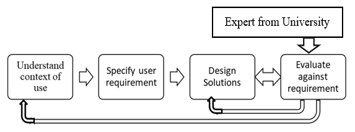 Figure 3: User-Centered Design
Figure 3: User-Centered Design
 Figure 4: Student Absence Log from Recent System
Figure 4: Student Absence Log from Recent System
3.3 User-Centered Design (UCD)
This qualitative research study uses the User-Centered Design (UCD) approach. This technique is chosen to ensure the simulation results are more focused on the user (user) and industry [7]. The UCD technique creates simulation scenarios where user interaction occurs by communicating with experts in operational fields. For details, see figure 3.
4. Result and Discussion
This research using the simulation technique begins with data collection from the current system to record student attendance. Figure 4 shows the attendance log of the student’s attendance, and the detail is students with the id “2101675432” attend courses with the code “COMP6049” and class code LC01 on October 23, 2017 (10/23/2017) present in class at 3: 24.24 in room ANG523 face to face “F2F”.
From the attendance log report, Figure 4 is then simulated into the Blockchain (multichain) application. There is no customization on multichain used.
The lab configuration can be seen in Figure 5, which shows a node with the name chain1 and the multichain version 1.0.9 using the 10011 protocol.
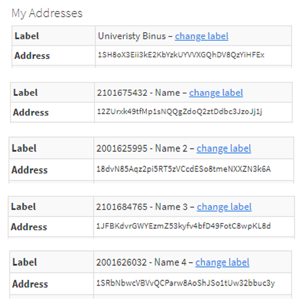 Figure 6: Multichain Addresses
Figure 6: Multichain Addresses
The address configuration represents a university and student entity. In this case, the entity functions are to send assets that record attendance transactions that occur during the teaching and learning transaction.
The address configuration shows in Figure 6, which describes all entities’ addresses for simulating attendance transactions.
After address configuration, the next configuration is asset formation. Assets represent courses, classrooms, and schedules in face-to-face mode (model).
Figure 7 explains the teaching and learning preparation (courses, classrooms, and the schedule) by the lecturer (KD_Lec), lecture schedule shift (15:20-17:00), and student classes.
Figure 8 shows the success of recording the program schedule, which is represented as an asset on the multichain.
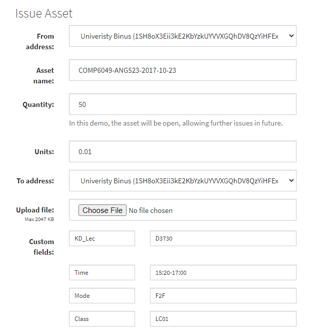 Figure 7: Input Dashboard 1 – Comp 6049
Figure 7: Input Dashboard 1 – Comp 6049
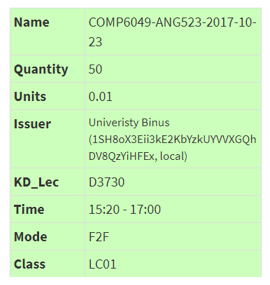 Figure 8: Success Result Input
Figure 8: Success Result Input
Figure 9 shows a simulation for filling the lecture schedule of COMP6065 course in classroom 521 on December 22, 2017, by KD_Lec (D3730) teachers with a face-to-face model and class LC01 student classes.
 Figure 9: Input Dashboard 2 – COMP6065
Figure 9: Input Dashboard 2 – COMP6065
Figure 10 illustrates the lecture schedule that has been successfully recorded on multichain (Blockchain) as assets. Figure 10 shows the number of students in the class so the assets can be sent to students present, while the attendance date follows the recording date on multichain.
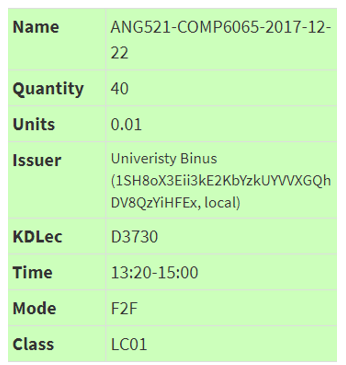 Figure 10: Success Result Input – Class 2
Figure 10: Success Result Input – Class 2
Figure 11 shows attendance transactions for a student 2101684765 – Name 3 with attendance at the COMP6049 course, on ANG campus with classroom 523 on October 23, 2017.
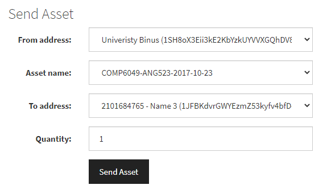 Figure 11: Attendance Activity
Figure 11: Attendance Activity
Figure 12 shows the transactions record of a student who attended the lecture. This recording proves that multichain (Blockchain) can facilitate to record student attendance activities in the face-to-face learning process that has occurred.
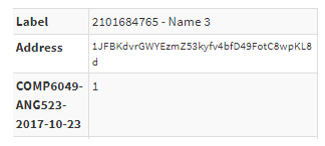 Figure 12: Attendance Record in Multichain
Figure 12: Attendance Record in Multichain
The simulation results reported in this paper are not all transactions shown in Figure 5, but the simulation is carried out thoroughly. The simulation involves experts from 9 universities, and all universities agree that the student attendance recording transaction can be done on the Blockchain (Multichain).
This research will complement previous research were using Blockchain (multichain) to become a database in recording student attendance transactions will be more robust because student attendance records cannot be manipulated.
5. Conclusion, Limitation and Future Research
This research uses qualitative methods using several techniques, such as FGD with experts and literature reviews. The simulation results are carried out directly by comparing the existing system’s attendance logs with multichain results.
This research produces a product that can be used to implement and become solutions in recording student attendance.
Other things that still need to be improved such as multichain configuration using only one node (single node), which should be at least 3 (three) nodes (best practice). Another thing is that there is no wallet created so that students cannot see the simulation’s results. It can be used to be developed in future research.
Conflict of Interest
The authors declare no conflict of interest.
Acknowledgment
This work is partially supported by the Directorate General of Strengthening for Research and Development of Research, Technology, and Higher Education, the Republic of Indonesia as part of Penelitian Dasar Unggulan Perguruan Tinggi”. Research Grant to Binus University entitled “Implementasi Blockchain Platform Untuk Menciptakan “Good Governance” pada Perguruan Tinggi” or “The Implementation of Blockchain Platform to Create “Good Governance” in Higher Education” with contract number: 12/AKM/PNT/2019 and contract date: March 27, 2019. The authors also gratefully acknowledge the reviewers’ helpful comments and suggestions, which have improved the presentation.
- L.M. Palma, M.A.G. Vigil, F.L. Pereira, J.E. Martina, ‘Blockchain and smart contracts for higher education registry in Brazil’, International Journal of Network Management, (June 2018), 1–21, 2019, doi:10.1002/nem.2061.
- K. Al Harthy, ‘The upcoming Blockchain adoption in Higher- education: requirements and process’, 2019 4th MEC International Conference on Big Data and Smart City (ICBDSC), 1–5, 2019.
- H. Sun, X. Wang, X. Wang, ‘Application of blockchain technology in online education’, International Journal of Emerging Technologies in Learning, 13(10), 252–259, 2018, doi:10.3991/ijet.v13i10.9455.
- Meyliana, Y.U. Chandra, C. Cassandra, Surjandy, H.A.E. Widjaja, E. Fernando, H. Prabowo, and C. Joseph, ‘DEFYING THE CERTIFICATION DIPLOMA FORGERY WITH BLOCKCHAIN PLATFORM: A PROPOSED MODEL’, in IADIS International Conference ICT, Society and Human Beings 2019 (part of MCCSIS 2019, 63–71, 2019.
- G. Greenspan, MultiChain White Paper | MultiChain, Multichain.Com, 2015.
- D. Bauman, P. Lindblom, C. Olsson, Blockchain – Decentralized trust, 2016, doi:http://entreprenorskapsforum.se/wp-content/uploads/2016/10/NaPo_Blockchain_webb.pdf.
- N. Kshetri, ‘Blockchain’s roles in strengthening cybersecurity and protecting privacy’, Telecommunications Policy, (September), 1–12, 2017, doi:10.1016/j.telpol.2017.09.003.
- P.Y. Chang, M.S. Hwang, C.C. Yang, ‘A blockchain-based traceable certification system’, Advances in Intelligent Systems and Computing, 733, 363–369, 2017, doi:10.1007/978-3-319-76451-1_34.
- M. Turkanovic, M. Holbl, K. Kosic, M. Hericko, A. Kamisalic, M. Turkanovi, ‘EduCTX: A blockchain-based higher education credit platform’, IEEE Access, X(January), 1–15, 2018, doi:10.1109/ACCESS.2018.2789929.
- T. Ahram, A. Sargolzaei, S. Sargolzaei, J. Daniels, B. Amaba, ‘Blockchain technology innovations’, 2017 IEEE Technology and Engineering Management Society Conference, TEMSCON 2017, (2016), 137–141, 2017, doi:10.1109/TEMSCON.2017.7998367.
- Fitri, Menteri Nasir: Jual Ijazah Palsu, 4 Kampus Dibekukan, Dua Rektor Dicopot (Minister Nasir: Selling fake diplomas certificate, 4 campuses frozen, two chancellors dismissed), Lldikti12.Ristekdikti.Go.Id, 2015.
- M.A. Safi’Ie, R. Hartono, G. Pratama, ‘The development of Student Attandance System using RFID and Internet of Things (IoT) technology’, IOP Conference Series: Materials Science and Engineering, 578(1), 8–13, 2019, doi:10.1088/1757-899X/578/1/012084.
- I.D. Foundation, What is User Centered Design | Interaction Design Foundation, Www.Interaction-Design.Org, 2020.
- T. Lowdermilk, User-Centered Design, O’Reilly Media, USA;, 2013.
- S. Nakamoto, Bitcoin P2P e-cash paper, 2008.
- M. Swan, Blockchain Blueprint for a New Economy, 1st ed., O’Reilly Media, Inc., 1005 Gravenstein Highway North, Sebastopol, CA 95472, USA, 2015.
- M.B. Hoy, ‘An Introduction to the Blockchain and Its Implications for Libraries and Medicine’, Medical Reference Services Quarterly, 36(3), 273–279, 2017, doi:10.1080/02763869.2017.1332261.
- H.M. Gazali, R. Hassan, R.M. Nor, H.M.. Rahman, ‘Re-inventing PTPTN study loan with blockchain and smart contracts’, in 2017 8th International Conference on Information Technology (ICIT), IEEE: 751–754, 2017, doi:10.1109/ICITECH.2017.8079940.
- A. Srivastava, ‘A Distributed Credit Transfer Educational Framework based on Blockchain’, 2018 Second International Conference on Advances in Computing, Control and Communication Technology (IAC3T), 54–59, 2018.
- Meyliana, Y.U. Chandra, C. Cassandra, . Surjandy, E. Fernando, H.A.E. Widjaja, H. Prabowo, ‘A Proposed Model of Secure Academic Transcript Records with Blockchain Technology in Higher Education’, in ConRist 2019, 172–177, 2020, doi:10.5220/0009907401720177.
- T.M. Fernández-caramés, ‘applied sciences Towards Next Generation Teaching , Learning , and Context-Aware Applications for Higher Education?: A Review on Blockchain, IoT , Fog and Edge Computing Enabled Smart Campuses and Universities’, 2019, doi:10.3390/app9214479.
- A.. Harzing, Publish or Perish, Harzing.Com, 2007.
- G. Hook, ‘Business Process Modeling and simulation’, in Proceedings – Winter Simulation Conference, 773–778, 2011, doi:10.1109/WSC.2011.6147804.
Citations by Dimensions
Citations by PlumX
Google Scholar
Scopus
Crossref Citations
- Amirul Mukhlis Bin Mohd Azli, Hazinah Kutty Mammi, Mazura Mat Din, Adlina Abdul-Samad, "Face-recognition based Attendance Authentication System." In 2023 International Conference on Data Science and Its Applications (ICoDSA), pp. 367, 2023.
- M.L. Dhore, Om More, Suraj Gaikwad, Kunal Ingawale, Shruti Devshatwar, "Hardware Based Attendance System Using Blockchain." In 2023 World Conference on Communication & Computing (WCONF), pp. 1, 2023.
- Lamia Hamza, Cherifa Azou, Ilham Bazizene, "Blockchain Technology for Absence Tracking." In 13th International Conference on Information Systems and Advanced Technologies “ICISAT 2023”, Publisher, Location, 2024.
- Ruchika Jain, Neena Seth, Kiran Sood, Simon Grima, "Mapping the Research on Blockchain in Education: A Systematic Review and Bibliometric Analysis." In Digital Transformation, Strategic Resilience, Cyber Security and Risk Management, Publisher, Location, 2023.
- Qingsen Zhang, "Attendance System based on Blockchain and Face Recognition." In 2022 International Conference on Smart Applications, Communications and Networking (SmartNets), pp. 1, 2022.
No. of Downloads Per Month
No. of Downloads Per Country

